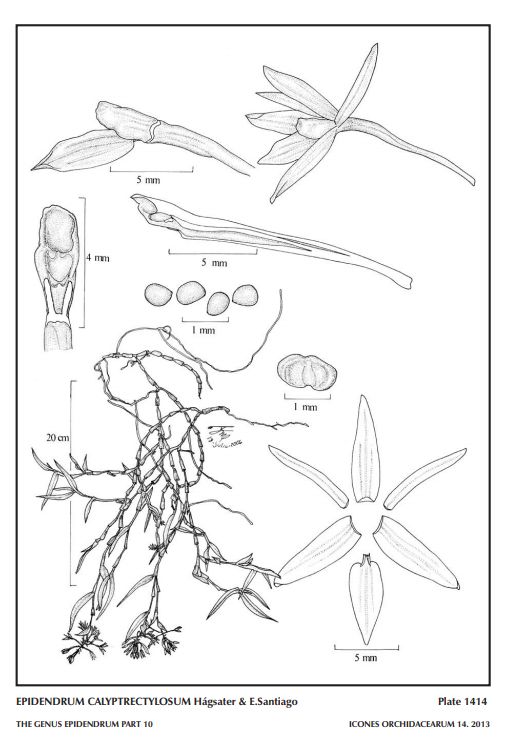

Epidendrum calyptrectylosum Hágsater & E.Santiago 2013 GROUP Megalospathum SUBGROUP Vesicicaule
TYPE Drawing by Hagsater & Jimenez and The AMO Herbaria Website



Common Name The Veiled No Calli Epidendrum [Refers to the very prominent clinandrium hood [Veiled] and the lack of a callus on the lip]
Flower Size .6” [1.5 cm]
Found in southwestern Colombia and northern Ecuador in cloud forests on the eastern slope of the Cordillera Oriental at elevations around 3000 to 3200 meters as a small sized, cold, pendent growing epiphyte with simple, arising on the basal 1/3 of the previoiu, cane-like, terete, thin, slightly sinuous stems basally enveloped by 2 to 3 infundibuliform sheaths and carrying 5 to 7 distributed throughout the apical 2/3's of the stem, alternate, articulate, unequal in size, linear-lanceolate, falcate, acuminate, minutely papillose margined leaves that blooms in the fall on a terminal, arising through an acuminate, conduplicate, oblique, margin obliquely papillose spathe, subumbelliform, short, pendulous, laxly simultaneously 6 to 17 flowered inflorescence with much shorter than the ovary, triangular-lanceolate, acuminate, amplexicaul floral bracts and carrying light green, resupinate flowers.
This species is in a group of about 12 species that have often in the past been considered synomonous and are spread from Colombia to Bolivia. The separated species include E. cardiomorphum, Epidendrum calyptratoides, E calyptratum, Epidendrum chaparense, Epidendrum falcivesicicaule, Epidendrum lagotis, Epidendrum pachyclinium, Epidendrum platypetalum and Epidendrum vesicicaule.
"Epidendrum calyptrectylosum belongs to GROUP Megalospathum S characterized by the caespitose but branching habit, many-leaved stem, fleshy, oblique leaves, a short, few flowered, raceme subtended by large semi-ovate spathaceous bracts, resupinate flowers, the column more or less united to the lip, and the SUBGROUP Vesicicaule, which has long, 3 to 8, narrow leaves, 8:1-20:1, and a simple lip. The species is recognized by the linear-lanceolate, falcate leaves, the 6 to 17 flowered sub-umbelliform inflorescence, with one or two ovate, acuminate spathaceous bracts, the minutely striated ovary which is not inflated, sepals .31to .36" [7.8 to 9 mm] long, the lanceolate to oblong, acute lip with the base slightly cordate, ecallose, and the very prominent clinandrium-hood with the margin entire. Epidendrum calyptratum has an ovate, acute lip with 2 minute calli, and the sepals are 6 mm long, and 10-12 flowers. Epidendrum schmidtchenii Hágsater & E. Santiago has fewer flowers (7), the ovary is inflated behind the lateral sepals forming a short vesicle, and has 3 ribs, the ribs being 2-winged, with the margin of the wings erose, the lip is oblong-elliptic, sub-rectangular, the base truncate, with a callus. Epidendrum calyptratoides Hágsater & Dodson has a narrowly semi-lanceolate spathaceous bract, the ovary is inflated, forming a somewhat elongate vesicle, 3-ribbed, the ribs 2-winged and erose, sepals ovate, lip elliptic and bicallose, and the clinandrium-hood is only slightly longer than the body of the column, the leaves are comparatively longer, 14:1 (length:width)." Hagsater etal 2013
Synonyms
References W3 Tropicos, Kew Monocot list , IPNI ; *Icones Orchidacearum 14 plate 1414 Hagsater 2013 drawing fide; Icones Orchidacearum 15 [2] Plate 1599 Hagsater & Sanchez 2016 see recognition section; Orquideas, Tesoro de Colombia Vol 2 Ortiz & Uribe 2017
--------------------------------------------------------------------------------------------------------------------------
----------------------------------------------------------------------------------------------------------------------------